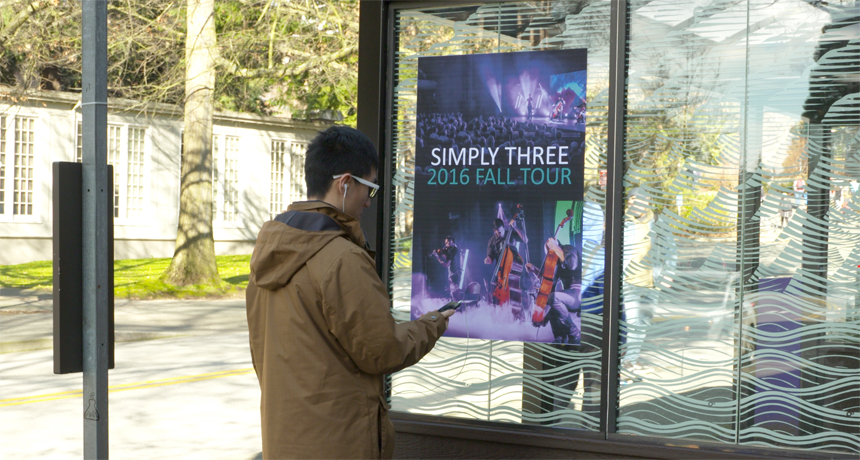These antennas turn anything into a radio station
A low-power approach to hijacks radio signals already moving through the air

A new device turns posters into radio stations. These smart posters could broadcast sound clips, such as from bands with upcoming concerts.
University of Washington
Look — and listen. That concert poster just might be singing. Engineers have designed antennas that can turn everyday objects, from posters to clothing, into radio stations. Anyone walking or driving by can tune in and hear what’s on. The devices use radio waves, but they don’t generate their own. They hijack the same waves that carry music and news to your smartphone.
Vikram Iyer is a graduate student in electrical engineering. He studies at the University of Washington in Seattle. He co-led the project with Anran Wang, a graduate student in computer science and engineering. Antennas don’t send out new waves. So they need little power. A button-sized battery could power an antenna for years. “It’s the ideal way to minimize the power consumption for any kind of communication,” notes Iyer.
The two got the idea for their invention by paying attention to what was already around them. Their research had focused on new types of wireless communications that won’t require much energy. They wanted something that would work outdoors in a city. Then they realized the air is already filled with wireless communications in the form of radio stations.
“In most cities, you have all these FM radio stations just pumping out power,” says Iyer. The duo wondered if they could find a way to harness that power.
Radio waves carry energy at the speed of light from tall transmission towers to radios in cars, phones and homes. These waves fill the air — especially in dense cities. The new devices take advantage of that. They take in existing radio waves and change them slightly. Those changes add new sound information. The altered waves are then sent back out into the world where people can listen in. So the device only needs enough power to change the waves, not generate them.
The scientists tested their device with a poster. It advertised a Seattle concert by Simply Three, a string trio. People standing almost 4 meters (12 feet) away from the poster could use FM receivers on smartphones to listen to snippets of the band’s music. Those in cars as far as 18 meters (59 feet) away could use car radios to pick up the songs.
FM stands for “frequency modulation.” Frequency is a measure of how many waves pass in one second. The higher the frequency, the closer the waves must pack together. In FM radio, sounds are encoded in the waves by making small changes in the wave frequencies. This is known as “modulating” the frequency.
When a radio wave hits something, it bounces off in a different direction. This is called scattering. Backscattering is what happens when the wave heads back in the opposite direction. The new antenna uses backscattering to send information. It doesn’t simply reflect a wave, though. It encodes a different signal on top of the existing wave by changing its frequency.
The enhanced waves don’t interfere with other radio stations. The new antenna changes the frequency of the wave so that the new message can be heard at a frequency not being using by an existing radio station. The original sound in the wave remains unchanged.
Electrical engineer Daniel Stancil says the idea of using existing FM signals “is an exciting one.” Stancil is an expert on antennas and communication at North Carolina State University in Raleigh. He did not work on the new study.
Iyer and his colleagues see many uses for their technology. Ads could broadcast sounds. Street signs could send out the name of an intersection or directions. They could also alert people when it’s safe to cross the street.
The technology could even extend to clothes. Iyer, Wang and their team stitched conductive thread into a cotton t-shirt. That thread conducts electricity. It turned the shirt into an antenna. It let the shirt talk to the wearer’s smartphone. If a sensor in the shirt tracked a person’s heart rate during exercise, for instance, the antenna could transmit those data to the wearer’s phone.
Iyer and Wang reported their success with the system at a March 2017 tech conference in Boston, Mass. Now they’re trying to figure out the best way to use it.
Stancil sees only one possible downside — that people are using FM radios less than they did in the past. “People are normally walking down the street listening to iPods instead,” he says.
This is one in a series presenting news on technology and innovation, made possible with generous support from the Lemelson Foundation.







